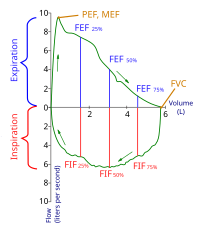
Photo from wikipedia
OBJECTIVE The aim of the study was to explore the feasibility of titrating tidal volume (V T) and positive end-expiratory pressure (PEEP) during one-lung ventilation (OLV) based on ventilation distribution… Click to show full abstract
OBJECTIVE The aim of the study was to explore the feasibility of titrating tidal volume (V T) and positive end-expiratory pressure (PEEP) during one-lung ventilation (OLV) based on ventilation distribution and oxygenation. APPROACH Twenty-four consecutive patients requiring intubation with a double-lumen tube and subsequent OLV for thoracic surgical procedures were examined prospectively in lateral posture. Electrical impedance tomography (EIT), blood gases, respiratory mechanics were successfully measured in 21 patients at various combinations of V T (4 ml kg-1, 6 ml kg-1, 8 ml kg-1 body weight) and PEEP (0 cm H2O, 4 cm H2O, 8 cm H2O) during OLV. MAIN RESULTS Low V T and low PEEP resulted in low global respiratory system compliance (C rs). Arterial partial pressure of O2 (PaO2) decreased with falling V T. Regional C rs measured with EIT showed high values at high V T and high PEEP in all but two patients. Regional C rs in mid and most dependent regions indicated tidal recruitment/derecruitment in eight patients at 8 ml kg-1 of V T and 4 cm H2O of PEEP; in four patients at 8 ml kg-1 and 0 cm H2O; in one patient at 6 ml kg-1 and 8 cm H2O. The changes in regional C rs induced by decreasing PEEP from 8 to 4 cm H2O were much smaller than those from 4 to 0 cm H2O. Ventilation distribution was most inhomogeneous with V T of 8 ml kg-1. All measures differed significantly among various V T and PEEP steps (p < 0.05). SIGNIFICANCE By using EIT in combination with PaO2, it is feasible to titrate V T and PEEP at the bedside during OLV.
Journal Title: Physiological measurement
Year Published: 2018
Link to full text (if available)
Share on Social Media: Sign Up to like & get
recommendations!